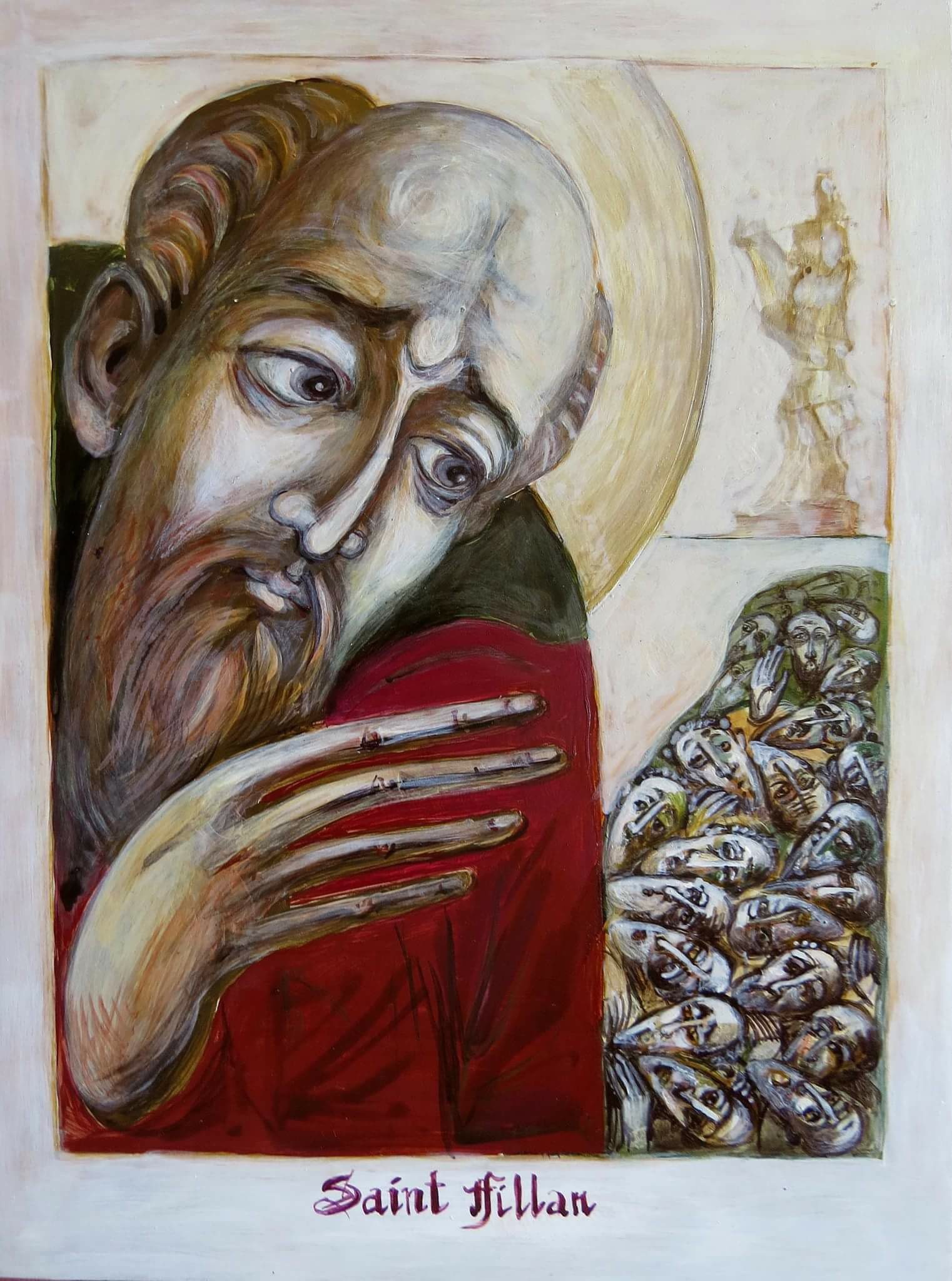St. Fillan is a significant figure in Christian mythology, particularly within the context of Scottish history and the Celtic Christian tradition. His life and deeds are steeped in legend, showcasing the interplay between faith and folklore. As a saint, Fillan is celebrated for his piety, miraculous abilities, and his role in spreading Christianity in the region. He is often associated with healing and is revered in various locations, especially in Scotland, where his legacy continues to influence local culture and religious practices.
Life of St. Fillan
The life of St. Fillan is not extensively documented, but various hagiographies provide insights into his background. He is believed to have lived during the 7th century, a time when Christianity was spreading throughout the British Isles. Fillan was likely born in what is now known as Scotland, and many accounts suggest that he was of noble lineage. His father was reportedly a king, which places Fillan in a unique position within the context of early Christian leaders. His royal background may have contributed to his influence and ability to attract followers.
 St. Fidelis Of Sigmaringen
St. Fidelis Of SigmaringenFillan’s early life is often depicted as one of deep devotion and commitment to God. According to legend, he became a monk, dedicating his life to prayer and service. He is often associated with the monastic community, which was essential in spreading Christianity during this era. Fillan is said to have founded several monasteries, which served as centers of learning and spiritual growth. These monasteries played a crucial role in the conversion of many pagans to Christianity, as they provided a place for education and worship.
Miracles and Legends
One of the most captivating aspects of St. Fillan’s story is the numerous miracles attributed to him. These miracles not only highlight his sanctity but also serve to inspire faith among his followers. Many of the legends surrounding Fillan involve his ability to heal the sick and perform other miraculous acts. For instance, he is often credited with curing ailments and providing comfort to those in distress. These stories have been passed down through generations, contributing to his reputation as a powerful intercessor.
One particularly famous miracle involves a blind man who was restored to sight through Fillan’s prayers. This event is often recounted in the context of his healing ministry. Such miracles were significant in the early Christian community, as they demonstrated the power of faith and the presence of the divine in everyday life. Fillan’s ability to perform miracles solidified his status as a saint and made him a figure of great veneration.
 St. Ferdinand Iii Of Castille
St. Ferdinand Iii Of CastilleKey Miracles of St. Fillan
- Restoration of sight to the blind
- Healing of the sick and infirm
- Exorcism of evil spirits
- Providing sustenance during times of famine
Another remarkable legend tells of Fillan’s encounter with a serpent that terrorized the local population. According to the tale, Fillan confronted the serpent and, through the power of his faith, was able to subdue it. This story symbolizes the triumph of good over evil and reflects the broader struggle between Christianity and paganism during that time. Such tales were essential in establishing the authority of the Church and reinforcing the idea that Christian saints could protect their communities from harm.
Cult and Veneration
The veneration of St. Fillan is particularly prominent in Scotland, where numerous churches and sites are dedicated to him. His cult grew over the centuries, and he became one of the most beloved saints in the region. The Feast of St. Fillan is celebrated on January 8, and various local traditions and customs have developed around this day. People often participate in special services, and some communities engage in processions to honor the saint.
In addition to formal celebrations, St. Fillan’s influence can be seen in various local practices. Many people still visit his shrines, seeking his intercession for health and protection. The Holy Well of St. Fillan, located in the Perthshire region, is one such site where pilgrims come to pray and seek healing. The water from this well is believed to possess miraculous properties, further emphasizing Fillan’s enduring legacy as a healer.
 St. Felix Of Nola
St. Felix Of NolaArt and Literature
The impact of St. Fillan extends beyond religious practices into the realms of art and literature. Various manuscripts and texts recount his life and miracles, contributing to the rich tapestry of Scottish hagiography. These writings serve not only as records of his deeds but also as inspirational tales that encourage faith among readers. The stories of St. Fillan are often filled with vivid imagery, making them accessible and engaging for a wide audience.
In art, St. Fillan is frequently depicted in iconography that highlights his role as a healer and protector. Artists often illustrate scenes of his miracles, portraying him surrounded by those he has helped. Such representations serve to communicate his significance and to inspire devotion among the faithful. The visual portrayal of saints, including Fillan, played a vital role in the religious life of communities, especially in times when literacy rates were low.
Notable Works about St. Fillan
- Life of St. Fillan – Various manuscripts
- Legends of the Scottish Saints
- Folklore and Tales of the Celtic Church
Additionally, St. Fillan’s story has been a source of inspiration for many writers and poets throughout the ages. His life and deeds have been woven into the fabric of Scottish folklore, highlighting the deep connection between religion and culture. These narratives often emphasize themes of faith, perseverance, and the battle against evil, reflecting the values of the communities that celebrate him.
St. Fillan in Modern Times
In contemporary society, the legacy of St. Fillan continues to resonate with many people. His life and miracles are still celebrated in various forms, from church services to local festivals. The enduring popularity of St. Fillan speaks to the lasting impact of his story on Scottish culture and the wider Christian tradition. Many communities honor his memory through events that highlight his contributions to the faith and his role as a protector of the people.
Moreover, the pilgrimage to sites associated with St. Fillan remains a popular practice. Many individuals undertake these journeys as a form of spiritual renewal or healing, reflecting the saint’s ongoing relevance in their lives. These modern pilgrimages often serve as a way for individuals to connect with their heritage and faith, reinforcing the communal aspects of worship and devotion.
Comparative Analysis with Other Saints
St. Fillan’s story can be compared to those of other saints within the Christian tradition. Like many saints, Fillan’s life is characterized by a commitment to God, miraculous deeds, and a strong connection to the local community. Saints such as St. Patrick and St. Columba also played significant roles in the spread of Christianity in the British Isles, and their stories share similar themes of healing and protection.
One notable comparison is between St. Fillan and St. Patrick. Both saints are celebrated for their missionary work and miraculous abilities. However, while St. Patrick is often associated with the conversion of Ireland, St. Fillan is more closely linked to the establishment of Christianity in Scotland. Their stories highlight the diverse ways in which Christianity spread across the British Isles and the unique cultural contexts in which these saints operated.
Common Themes Among Saints
- Miraculous healings
- Conversion of pagans
- Protection against evil
- Establishment of monastic communities
Additionally, St. Fillan’s emphasis on healing is a common theme found in many saintly narratives. The ability to heal not only serves as a testament to the saint’s holiness but also reflects the needs and aspirations of the communities that venerate them. This connection between the saint’s miracles and the practical concerns of the faithful underscores the important role that saints play in the lives of believers.
Theological Significance of St. Fillan
The life of St. Fillan holds significant theological implications within the Christian tradition. His commitment to a life of prayer and service exemplifies the call to holiness that is central to Christian teaching. Fillan’s story invites believers to reflect on their own spiritual journeys and to consider the ways in which they can live out their faith in everyday life. His dedication to God and the community serves as a model for Christians seeking to deepen their relationship with the divine.
Moreover, the miracles attributed to St. Fillan highlight the belief in the power of intercession. Many Christians believe that saints can intercede on their behalf, bringing their prayers before God. Fillan’s reputation as a healer and protector reinforces this belief, encouraging individuals to seek his intercession in times of need. This aspect of his legacy speaks to the broader understanding of the communion of saints within the Christian faith, emphasizing the interconnectedness of believers across time and space.
St. Fillan’s Influence on Scottish Culture
St. Fillan’s impact on Scottish culture extends beyond religious practices; he has also influenced various aspects of Scottish identity. His life and miracles have been woven into the fabric of Scottish folklore, contributing to a rich cultural heritage that celebrates the interplay between faith and tradition. Festivals and celebrations dedicated to St. Fillan often feature music, dance, and storytelling, reflecting the vibrant culture of the region.
Additionally, St. Fillan’s story has inspired various forms of artistic expression, from literature to music. Many contemporary Scottish musicians and writers draw upon the themes of his life, incorporating them into their work. This artistic engagement with the saint’s legacy serves to keep his memory alive and to promote a sense of cultural pride among the Scottish people.
St. Fillan in Literature and Arts
- Poems celebrating his miracles
- Paintings depicting his life
- Musical compositions inspired by his story
Furthermore, St. Fillan’s influence can be seen in the preservation of local traditions and customs that honor his memory. Many communities engage in practices that reflect the saint’s values, such as acts of charity and service to others. These actions not only pay homage to St. Fillan but also foster a sense of community and shared purpose among individuals.
Conclusion: St. Fillan’s Enduring Legacy
St. Fillan’s legacy continues to thrive in contemporary society, reflecting the deep-rooted connection between faith and culture in Scotland. His life, characterized by miracles, healing, and dedication to God, serves as a source of inspiration for many. The ongoing veneration of St. Fillan highlights the importance of saints in the Christian tradition and their role in the spiritual lives of believers. As communities continue to celebrate his memory, St. Fillan remains a vital part of Scotland’s rich cultural and religious heritage.
